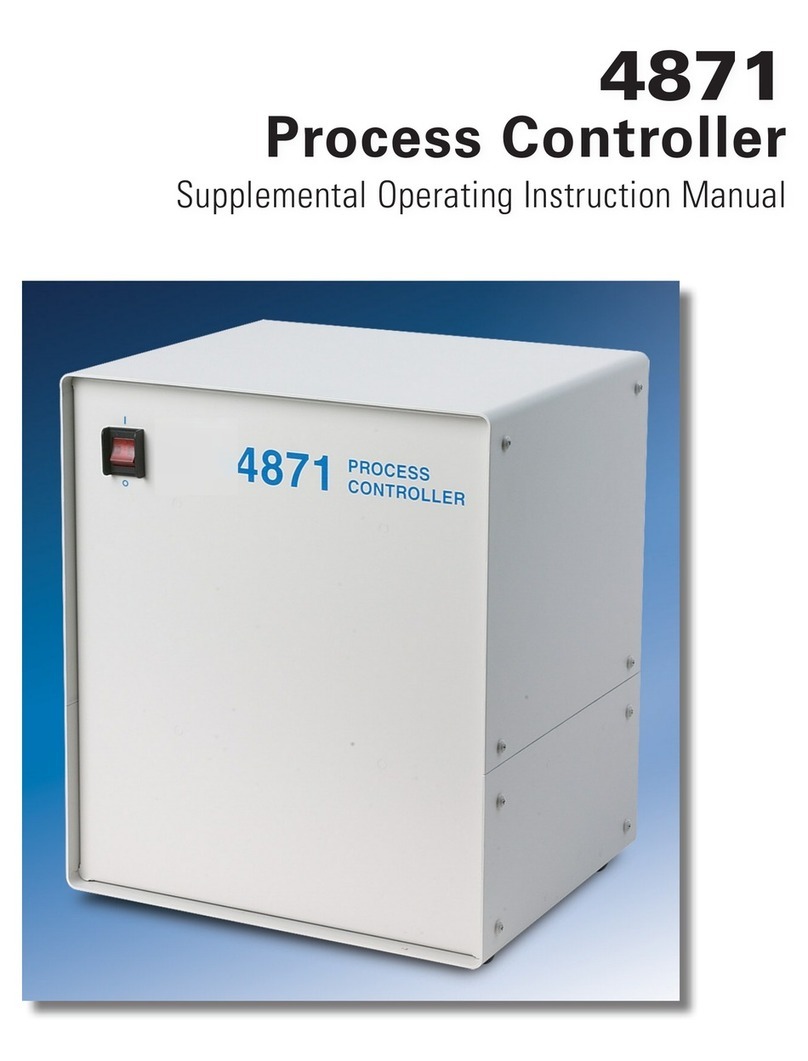
4838 Reactor Controller
10
Instructions for the 4838 Reactor
Controller
Caution!
Check that controller settings are set to
factory defaults before operating for the first
time. The default settings are listed at the
back of this manual.
Note: Controller parameters can be found in
Appendix A on page 21 of this manual.
Temperature Control Module
PRIMARY
TEMPERATURE
The 4838 Reactor Controllers have a microprocessor
based control module that provides full three-term
PID control with adjustable tuning parameters. The
temperature control interface is labeled as Primary
Temperature on front panel.
To facilitate start up with reasonably good PID con-
trol, parameters for both heating and cooling are
pre programmed at the factory.
Output 1 on these controllers drives the heater. Out-
put 2 is not used on the 4838 Controller. The control
parameter can be set independently for this output.
Two lines of information, labeled PV and SV, are
shown on the display during normal operations.
The upper line (PV) shows the actual temperature
as read by the control thermocouple. The lower
line (SV) shows the set point. When the controller
is heating, the Out1 light will illuminate or blink.
When an alarm condition has been reached, the
ALM light will illuminate and trip the High Limit
Reset, cutting power to the heater.
Temperature Control
The easiest way to control temperature with the
4838 Controller is to use setpoint control. With set-
point control, the controller will attempt to bring the
temperature to the value of the setpoint by adjust-
ing the heater output.
The setpoint may be adjusted by doing the following:
1. Press the up or down arrow until the lower
display shows the desired setpoint. The lower
display will blink, showing the value has not
been set yet.
2. Press the set button. The lower display will stop
blinking, showing the new value has been set.
High Temperature Alarm Setpoint
The 4838 Reactor Controller also has a HighTem-
perature Alarm built into it. When the temperature
exceeds this limit, it will pop the High Limit Reset,
preventing power from going to the heater. The
HighTemperature Alarm setpoint may be adjusted
by doing the following:
1. Press the circular arrow key three times. The up-
per display will read AL1H and the lower display
will read the HighTemperature Alarm setpoint
(usually 375 °C).
2. Use the up or down arrow to adjust this to the
desired setpoint.
3. Press the up or down arrow until the lower
display shows the desired setpoint. The lower
display will blink, showing the value has not
been set yet.
4. Press the set button. The lower display will stop
blinking, showing the new value has been set.
5. Pressing the set button again will return the dis-
play to the main screen.
PID groups
a. The primary temperature controller contains
4 groups of PID parameters (PID0, PID1, PID2
and PID3), which can be used to store up to four
different sets of PID parameters. Each group is
identified by the SV used during the autotuning
cycle.
b. The parameter displayed is the group in use
with exception of PID4. When PID4 is set, the PID
parameters will automatically switch between
PID groups 0, 1, 2 and PID group 3, depending
on which group’s SV best matches the current
temperature (PV).





























